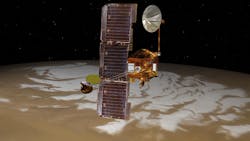NASA’s Mars Odyssey spacecraft, launched in 2001, is the longest-working spacecraft sent to the Red Planet. Yet neither Odyssey nor any other Mars orbiters have flown in a trajectory with a view of the ground in morning daylight. Scientists recently tweaked the Odyssey’s orbit to enable it to make the first systematic observations of how morning fogs, clouds, and surface frost develop during the planet’s different seasons.
Engineers at NASA’s Jet Propulsion Laboratory (JPL) and Lockheed Martin Space Systems are behind this shift, which will accelerate Odyssey’s drift toward a morning-daylight orbit. The change will be gradual with the intended geometry to be reached in November 2015. Another maneuver will then halt the drift. Following the final maneuver, the Odyssey will have enough propellant for 9 to 10 more years of operation.
As a result of this maneuver, the orbiter will be able to survey changing ground temperatures after sunrise and sunset. Such observations could provide insight into the composition of the ground and temperature-driven processes, such as warm-season flows seen on some slopes and geysers fed by the spring thawing of carbon-dioxide ice near Mars’ poles.
For its first six years, the Odyssey was positioned at an advantage for its gamma-ray spectrometer, which checks for evidence of water near the Martian surface. This led to discoveries as to how widely water ice—detected as hydrogen—and other elements are distributed. The Odyssey was then repositioned to allow for better mineral mapping by a thermal emission imaging system (THEMIS). Mid-afternoon warmth made the minerals’ infrared signatures easier to identify. But the timing added stress to the solar power system, as more of the orbit was pushed into the planet’s shadow. THEMIS principal investigator, Philip Christensen, proposed the most recent shift, which will also help to preserve the spacecraft’s aging battery.
About the Author
Iliza Sokol
Associate Digital Editor
Iliza joined the Penton Media group in 2013 after graduating from the Fashion Institute of Technology with a BS in Advertising and Marketing Communications. Prior to joining the staff, she worked at NYLON Magazine and a ghostwriting firm based in New York.
